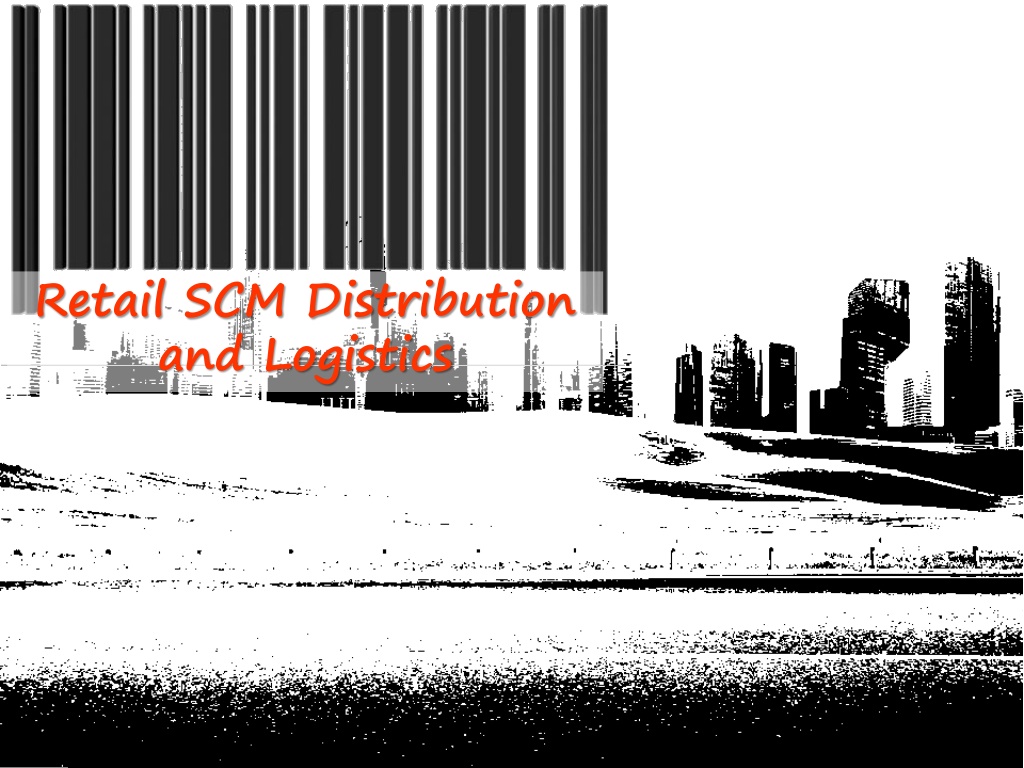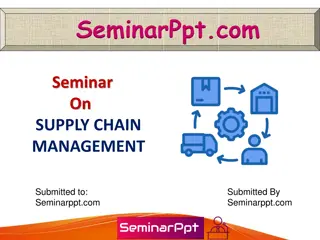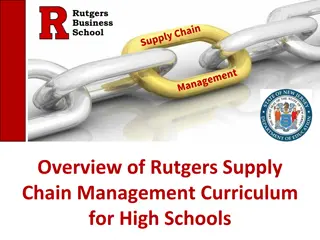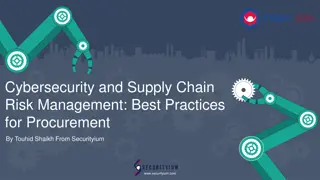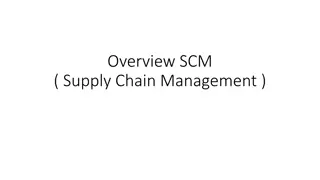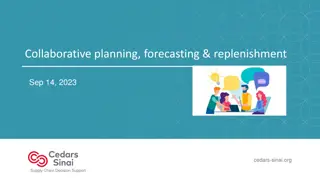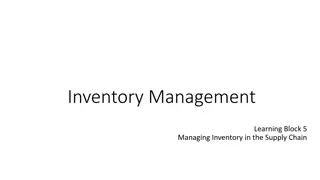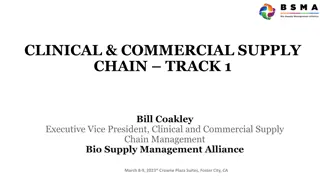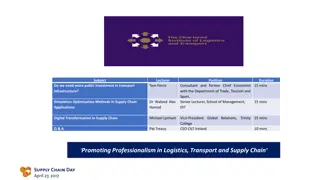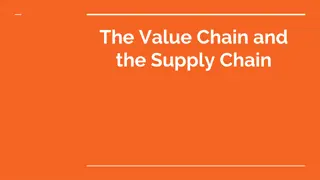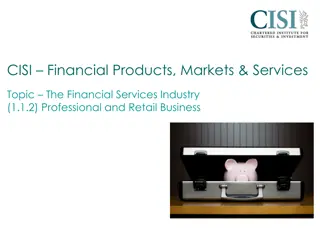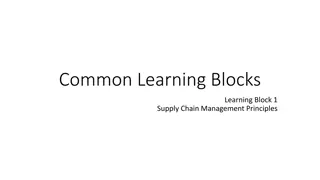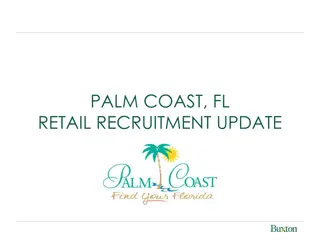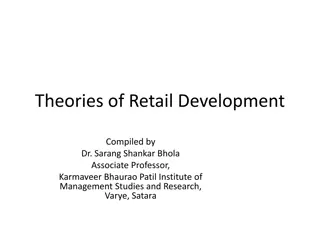Understanding Retail Supply Chain Management: Strategies and Challenges
Explore the world of Retail Supply Chain Management (SCM) through the eyes of Kate Slovensky, a housewife facing product availability challenges. Delve into the basics of SCM, logistics, distribution management, and the impact of information technology and reverse logistics in retail. Gain insights into key strategies and tips for effective SCM in the retail industry.
Download Presentation

Please find below an Image/Link to download the presentation.
The content on the website is provided AS IS for your information and personal use only. It may not be sold, licensed, or shared on other websites without obtaining consent from the author. Download presentation by click this link. If you encounter any issues during the download, it is possible that the publisher has removed the file from their server.
E N D
Presentation Transcript
Retail SCM Distribution and Logistics
Course Objective Explain What is Retail Supply Chain Management Describe the Basic Supply Chain in Retailing Explain What is Supply Chain Node Design (SCND) Explain the Role of Logistics in Retail SCM Describe the Strategies for Retail Logistics Management Explain the Steps of Cross Docking Process Explain the Push/Pull Strategies of SCM Explain the Retail Warehouse Management System Describe the Key Strategies for Distribution Management Explain the Factors Contributing to Bull Whip Effect Explain the Types of Retail Supply Chain Models Describe the Role of Information Technology in Retail SCM Explain the Role of Reverse Logistics in Retail SCM List the Challenges of Retail SCM List the Tips for Effective Retail SCM
Introduction Kate Slovensky is a housewife and regularly visits her local supermarket, You & Us to shop for groceries, clothes and fruits.
Introduction However, lately she has found that many of the brands that were earlier available with You & Us are most of the times out of stock . She is greatly disappointed by the lack of options in some of her key needed brand of products such as Cosmetics, Shampoo, and Coffee etc.
Introduction Kate has been thinking of going to another retail store where she would be able to get more options of choosing various products such as of national or local brands, private label products of economy, value or premium quality or fresh or canned products.
Introduction Therefore, Kate decides to try one of the bigger stores for the brands that she is looking for. There are many large retailers available in her city such as the ones shown on the screen.
Introduction Each of these retailers stocks various brands of products in different categories. Kate decides to try Wal-Mart for her shopping needs. Wal-Mart is a successful retailer that is engaged in selling merchandise for personal or household consumption.
Introduction Kate finds as she goes to Wal-Mart to shop month after month for her groceries and other needs that Wal-Mart always has a good stock of all the various brands every time. She never finds any brand being out of stock . Thus, Kate is able to buy the brands that she likes every time.
Introduction So, how does Wal-Mart achieve this good stock of various brands? How is Wal-Mart able to satisfy the needs of Kate as well as several of its customers and please them every time?
Introduction Retail Supply Chain is the flow and management of resources across the retail enterprise for the purpose of maintaining the business operation profitably. It is the management of a network of all retail business processes and retail activities involving procurement of raw materials, manufacturing and distribution management of Finished Goods.
Introduction Wal-Mart achieves this stupendous success with each of its customers through the use of a very effective and efficient Retail Supply Chain Management and Logistics System .
Introduction Retail SCM is also called the Art of management of providing the Right Product, At the Right Time, Right Place and at the Right Cost to the Customer . An effective and efficient Retail Supply Chain Management and Logistics System is crucial for each and every retail business success.
Introduction Thus, a strong and efficient Retail Supply Chain Management and Logistics System provides a firm foundation and backbone for success in any kind of retail business whether the retailer comprises of street vendors, local grocery stores, supermarkets, automobile showrooms, internet kiosks, home appliance showrooms, direct marketers, etc.
What is Retail Supply Chain Management? Supply Chain is the flow and management of resources across the retail enterprise for the purpose of maintaining the retail operation profitably. Retail SCM can be defined as the management of a network of all retail business processes and activities involving procurement of raw materials, manufacturing and distribution management of finished goods to reach the end user. SCM is also called the art of management of providing the Right Product, At the Right Time, Right Place and at the Right Cost to the Customer.
Drivers of Retail Supply Chain Dynamics A retail supply chain is dynamic and chaotic, so, its structure must be very flexible to cope with capricious market demand and severe levels of competitions. A supply chain must be able to change its pattern easily to gain a competitive advantage. Drivers Customer satisfaction Technology change Connections Internal factors Multi-echelon decision making Scratched together partners Retail Supply Chain Dynamics Roll your mouse over the icon, to learn more. Negative effects Information-distortion/delay Bullwhip effect Boom and bust Competitiveness Flexible manufacturing Efficient operation Agility response
Solutions provided by Retail SCM 1 Distribution Network Configuration : Location, network of suppliers, distribution centers, production centers, warehouses, customers etc. 2 Distribution Strategy: Control of operations, delivery scheme, mode of transportation, replenishment strategy and transportation control 3 Trade-offs in Logistics: All the activities must be well coordinated to achieve the lowest total logistics cost. Trade-offs may increase the total cost if only one of the activities is optimized
Retail Supply Chain Planning and Execution Function BUY DISTRIBUTE SELL P L A N N I N G Network Planning Sourcing Demand Planning Replenish ment planning Demand Managem ent Inventory Planning Vendor Managem ent E X E C U T I O N Transportati on Inventory Manageme nt Order Management Demand Managem ent Warehous ing
Retail SCM & Allocation Planning Allocation planning is another strategy for replenishments. This type of replenishment strategy is sometimes called as pull-based strategy. This is because the replenishment at any given node is based on the demand signals from the downstream node that pulls the merchandise from the target node. Consider a retail store that requests merchandise from the warehouse when needed. This is an example of pull-based replenishment, where the retail store pulls the merchandise from the warehouse as need arises.
Retail Supply Chain & SCND These desirable locations will constitute the retail supply chain for most efficient flow of materials and merchandise. Supply Chain Network Design or SCND is the process of establishing the network nodes and flow paths in a retail supply chain. Supply chain network design is a critical process for distribution- intensive industries such as retail. Together, this network creates a complex set of flow paths along which the merchandise can flow. This process helps plan the most desirable physical locations and their types. These nodes can represent either manufacturing, stocking or distribution locations.
Logistics in Retail Supply Chain Management Logistics is the backbone on which Retail Supply Chains are driven. Logistics refers to management of flow of goods and supplies involving information, data and documentation between two entities or points.
Key Strategies for Retail Logistics Management There are three key strategies that are used by retailers for logistics management. They are as follows: Flow-Time Analysis Cross-docking Hub and Spoke Let s look at each in detail.
Flow-Time Analysis One of the most crucial components of retail supply chain is the speed with which the products move along the supply chain and ultimately reach the customer. Hence, flow time is the time it takes for the product to flow or move along the supply chain and reach the customer after the customer demand is made. Flow-Time Analysis
Push/Pull Strategies of SCM Pull Customization is High Demand is uncertain Scale economies are Low E.g., Computer Peripherals Demand is uncertain Scale economies are High Low economies of scale E.g., Furniture High Demand of uncertainty Uncertainty is low Low economies of scale Push-pull supply chain E.g., Stationeries Standard processes are the norm Demand is stable Scale economies are High E.g., Soft drinks Low Low High Push Economies of scale Pull Push
Cycle Count Process The Warehouse Management System carries out the following functions: Another critical function of WMS is the cycle count process which is required to maintain the health of the inventory. WMS initiates daily cycle count and wall to wall counts as per user specification and attributes. Let us look at each in detail.
Bull Whip Effect The given image shows how the Bull Whip Effect has distorted the actual number of products required at the point of sale as compared to the number of products being manufactured at the manufacturer s factory. Quantity of Products Customer Supplier Manufacturer
Model 1: Online-Only/In-House Supply Chain Model 1: Online-Only/In-House Supply Chain The Online-Only/In-House Supply Chain Model focuses on fulfilling orders quickly with a high rate of accuracy and also optimizing shipping times to customers. This model achieves this quick turnaround time by greatly depending upon extensive product sales forecasting and inventory management systems. An example of a retailer who uses this model is: Amazon.com
ManagementStudyGuide.com This is a DEMO Course On Retail SCM Distribution & Logistics. The Complete PPT consists of 248 Slides. Become a Member and Get Access to Complete Powerpoint Presentations for more than 140 Subjects. What Do you Get: 1. View All Courses Online. 2. Download Powerpoint Presentation for Each Course. 3. Do the Knowledge Checks for Each Course.
